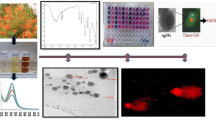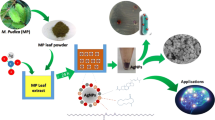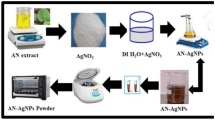Abstract
Biosynthesis of silver nanoparticles (AgNPs) is an easy, environmentally benign or eco-friendly process with very less or no cost and is having immense applications in biotechnological, biomedical, agricultural and environmental fields. In the present investigation, AgNPs were successfully synthesized for the first time using an aqueous leaf extract of Momordica cymbalaria from 6 mM silver nitrate solution. The synthesis of AgNPs was preliminarily confirmed by the color change of the reaction mixture and further confirmed and characterized by UV–Vis spectroscopy, FTIR, SEM and XRD. The UV–Vis spectrum confirmed the presence of AgNPs between the wavelength range of 300–600 nm, with the highest peak area of 422 nm. XRD and SEM analyzes showed an average particle size of 16.58 nm with smooth-surface spherical-shaped silver nanoparticles. The FTIR spectrum analysis of silver nanoparticles reveals different functional groups such as primary amines (–NH2), secondary amines (–NH–), aldehydes (–CHO), ketone (C=O), carboxylic acid (–COOH), alkynes and SP3 carbons respectively. Furthermore, these biosynthesized nanoparticles showed antibacterial activity against multidrug-resistant human pathogens.








Similar content being viewed by others
References
Kiranmai M (2017) Biological and non-biological synthesis of metallic nanoparticles: scope for current pharmaceutical research. Indian J Pharm Sci 79(4):501–512. https://doi.org/10.4172/pharmaceutical-sciences.1000256
Zhang D, Ramachandran G, Mothana RA, Siddiqui NA, Ullah R, Almarfadi OM, Rajivgandhi G, Manoharan N (2020) Biosynthesized silver nanoparticles using Caulerpa taxifolia against A549 lung cancer cell line through cytotoxicity effect/morphological damage. Saudi J Biol Sci 27(12):3421–3427. https://doi.org/10.1016/j.sjbs.2020.09.017
Parashar V, Parashar R, Sharma B, Pandey AC (2009) Parthenium leaf extract mediated synthesis of silver nanoparticles: a novel approach towards weed utilization. Dig J Nanomater Biostructures (DJNB) 4(1):45–50
Zomorodian K, Pourshahid S, Sadatsharifi A, Mehryar P, Pakshir K, Rahimi MJ, Arabi Monfared A (2016) Biosynthesis and characterization of silver nanoparticles by Aspergillus species. Bio Med Res Int. https://doi.org/10.1155/2016/5435397
Rautela A, Rani J, Das Debnath M (2019) Green synthesis of silver nanoparticles from Tectona grandis seeds extract: characterization and mechanism of antimicrobial action on different microorganisms. J Anal Sci Technol 10(5):2–10. https://doi.org/10.1186/s40543-018-0163-z
Patra S, Mukherjee S, Barui AK, Ganguly A, Sreedhar B, Patra CR (2015) Green synthesis, characterization of gold and silver nanoparticles and their potential application for cancer therapeutics. Mater. Sci Eng, C 53:298–309. https://doi.org/10.1016/j.msec.2015.04.048
Gandhiraj V, Sathish Kumar K, Narendrakumar G (2018) Biotic synthesis of silver nanoparticles from Momordica charantia (Cucurbitaceae) and its characterization studies. Res J Biotech 13(9):91–99
Siddiqui MN, Redhwi HH, Achilias DS, Kosmidou E, Vakalopoulou E, Ioannidou MD (2018) Green synthesis of silver nanoparticles and study of their antimicrobial properties. J Polym Environ 26(2):423–433. https://doi.org/10.1007/s10924-017-0962-0
Abisharani JM, Devikala S, Dinesh Kumar R, Arthanareeswari M, Kamaraj P (2019) Green synthesis of TiO2 Nanoparticles using Cucurbita pepo seeds extract. Materi Today Proc 14(2):302–307. https://doi.org/10.1016/j.matpr.2019.04.151
Ahmed MJ, Murtaza G, Rashid F, Iqbal J (2019) Eco-friendly green synthesis of silver nanoparticles and their potential applications as antioxidant and anticancer agents. Drug Dev Ind Pharm 45(10):1682–1694. https://doi.org/10.1080/03639045.2019.1656224
Das G, Patra JK, Basavegowda N, Vishnuprasad CN, Shin HS (2019) Comparative study on antidiabetic, cytotoxicity, antioxidant and antibacterial properties of biosynthesized silver nanoparticles using outer peels of two varieties of Ipomoea batatas (L.). Lam. Int J Nanomedicine 2(14):4741–4754. https://doi.org/10.2147/IJN.S210517
Amkamwar B, Damle C, Ahmad A, Satry M (2005) Biosynthesis of gold and Ag nanoparticles using Emblica officinalis fruits extract, their phase transfer and transmetalation in an organic solution. J Nanosci Nanotechnol 5:1665–1671. https://doi.org/10.1166/jnn.2005.184
Schaffer B, Hohenester U, Trugler A, Hofer F (2009) Highersolution surface plasmon imaging of gold nanoparticles by energy-filtered transmission electron microscopy. Phys Rev B 79:0414011–0414014. https://doi.org/10.1103/PhysRevB.79.041401
Mmola M, Roes-Hill ML, Durrell K, Bolton JJ, Sibuyi N, Meyer ME, Beukes DR, Antunes E (2016) Enhanced antimicrobial and anticancer activity of silver and gold nanoparticles synthesised using Sargassum incisifoliumaqueous extracts. Molecules 21(12):1633. https://doi.org/10.3390/molecules21121633
Heatley NG (1944) A method for the assay of penicillin. Biochem J 38:61–65. https://doi.org/10.1042/bj0380061
Magiorakos AP, Srinivasan A, Carey RB, Carmeli Y, Falagas ME, Giske CG, Harbarth S, Hindler JF, Kahlmeter G, Olsson-Liljequist B, Paterson DL (2012) Multidrug-resistant, extensively drug-resistant and pandrug-resistant bacteria: an international expert proposal for interim standard definitions for acquired resistance. Clin Microbiol Infect 18(3):268–281
Wang CY, Chen YH, Fang C, Zhou MM, Xu HM, Jing CM, Deng HL, Cai HJ, Jia K, Han SZ, Yu H (2019) Antibiotic resistance profiles and multidrug resistance patterns of Streptococcus pneumoniae in pediatrics: a multicenter retrospective study in mainland China. Medicine. https://doi.org/10.1086/595857
Dhivya G, Rajasimman M, 2015. Synthesis of silver nanoparticles using Momordica charantia and its applications. J Chem Pharmaceut Res .7(9):107–113.
Swamy MK, Akhtar MS, Mohanty SK, Sinniah UR (2015) Synthesis and characterization of silver nanoparticles using fruit extract of Momordica cymbalaria and assessment of their in vitro antimicrobial, antioxidant and cytotoxicity activities. Spectrochim Acta Part A Mol Biomol Spectrosc 151:939–944. https://doi.org/10.1016/j.saa.2015.07.009
Bykkam, S, Ahmadipour M, Narisngam S, Kalagadda VR, Chidurala SC (2015) Extensive studies on X-ray diffraction of green synthesized silver nanoparticles. Adv Nanopart 27: 4(1):1–10.https://doi.org/10.4236/anp.2015.41001.
Botcha S, Prattipati SD (2020) Callus extract mediated green synthesis of silver nanoparticles, their characterization and cytotoxicity evaluation against MDA-MB-231 and PC-3 Cells. Bio Nano Sci 10:11–22. https://doi.org/10.1007/s12668-019-00683-3
Anandalakshmi K, Venugobal J, Ramasamy V (2016) Characterization of silver nanoparticles by green synthesis method using Pedalium murex leaf extract and their antibacterial activity. Appl Nanosci 1:6(3):399–408. https://doi.org/10.1007/s13204-015-0449-z
Diantoro M, Fitrianingsih R, Mufti N, Fuad A (2014) Synthesis of silver nanoparticles by chemical reduction at various fraction of MSA and their structure characterization. In: AIP Conference Proceedings 24; 1589(1):257–261. https://doi.org/10.1063/1.4868795.
Mekala M, Suba Sri M, Suganya K (2019) Microencapsulation of Momordica cymbalaria (Athalakkai) fruit nanoparticle coated on cotton gauze for biomedical application. Aust J Basic Appl Sci 13(1):9–16. https://doi.org/10.22587/ajbas.2019.13.1.2
Kagithoju S, Godishala V, Nanna R.S (2015) Eco-friendly and green synthesis of silver nanoparticles using leaf extract of Strychnospotatorum Linn. F. and their bactericidal activities. 3 Biotech 5(5):709–714.https://doi.org/10.1007/s13205-014-0272-3
Savithramma N, LingaRao M, Suvarnalatha P (2011) Evaluation of antibacterial efficacy of biologically synthesized silver nanoparticles using stem barks of Boswellia ovalifoliolata Bal. and Henry and ShoreatumbuggaiaRoxb. J Biol Sci 11(1):39–45. https://doi.org/10.3923/jbs.2011.39.45
Elumalai EK, Prasad TNVKV, Hemachandran J, Therasa SV, Thirumalai T, David E (2010) Extracellular synthesis of silver nanoparticles using leaves of Euphorbia hirta and their antibacterial activities. J Pharm Sci Res 2(9):549–554
Pavani, C, Shasthree, T (2021) Biological activity of green synthesized silver nanoparticles and different plant extracts of Solanum khasianum Clarke. Int Res J Adv Sci Hub 3:12–17.https://doi.org/10.47392/irjash.2021.103.
Sondi I, Salopek-Sondi B (2004) Silver nanoparticles as antimicrobial agent: a case study on E. coli as a model for Gram-negative bacteria. J Colloid Interface Sci 275(91):177–182. https://doi.org/10.1016/j.jcis.2004.02.012.
Morones JR, Elechiguerra JL, Camacho A, Holt K, Kouri JB, Ramírez JT, Yacaman MJ (2005) The bactericidal effect of silver nanoparticles. Nanotechnology 169(10):2346–2353. https://doi.org/10.1088/0957-4484/16/10/059
Acknowledgements
The authors duly acknowledge the Department of Biotechnology, Kakatiya University, Warangal, for providing all the facilities for carrying out the research. The authors are thankful to UGC, SAP-DRS-II, NEW DELHI, India, for financial support.
Author information
Authors and Affiliations
Contributions
CG and PC conducted the experiment and analyzed the data, SK designed tables and figures, and ST designed the manuscript and finalized manuscript. All authors have read and approved the final manuscript.
Corresponding author
Ethics declarations
Conflict of interest
The authors declare that they have no conflicts of interest.
Ethical approval
This article does not contain any studies with human participants or animals performed by any of the authors.
Additional information
Publisher's Note
Springer Nature remains neutral with regard to jurisdictional claims in published maps and institutional affiliations.
Significance’ statement
AgNPs are simple and environmentally friendly; the process is very low or cost effective and has enormous applications in the fields of biotechnology, biomedical, agriculture and environment. It has been demonstrated and characterized using a combination of different methods such as UV–Vis spectroscopy, SEM, XRD, and FTIR. The surface Plasmon structure of AgNPs was confirmed. AgNPs have shown antibacterial activity against multidrug-resistant human pathogens.
Rights and permissions
About this article
Cite this article
Gopu, C., Chirumamilla, P., Kagithoju, S. et al. Green synthesis of silver nanoparticles using Momordica cymbalaria aqueous leaf extracts and screening of their antimicrobial activity. Proc. Natl. Acad. Sci., India, Sect. B Biol. Sci. 92, 771–782 (2022). https://doi.org/10.1007/s40011-022-01367-x
Received:
Revised:
Accepted:
Published:
Issue Date:
DOI: https://doi.org/10.1007/s40011-022-01367-x




